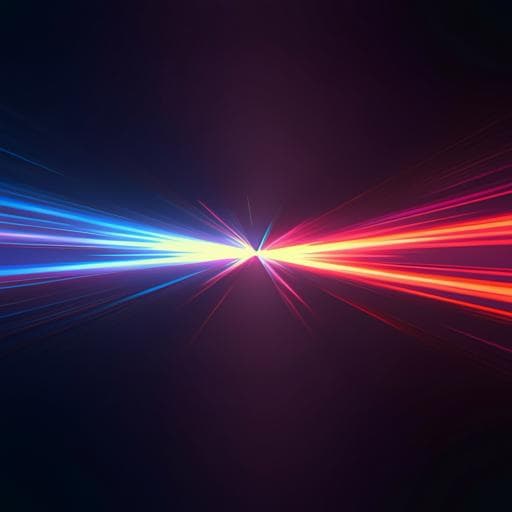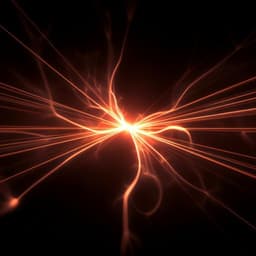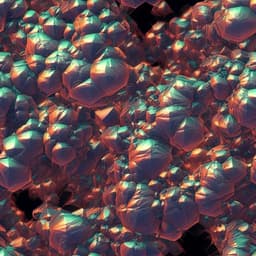
Physics
Ghost-imaging-enhanced noninvasive spectral characterization of stochastic x-ray free-electron-laser pulses
K. Li, J. Laksman, et al.
Discover a revolutionary methodology that combines high-acceptance angle-resolved photoelectron time-of-flight spectroscopy and ghost imaging to enhance the spectral characterization of x-ray free-electron laser pulses. The research, conducted by an expert team of authors, significantly improves energy resolution for ultrafast x-ray spectroscopy applications.
~3 min • Beginner • English
Introduction
The study addresses the challenge of noninvasively characterizing the stochastic, spectrally spiky pulses generated by self-amplified spontaneous emission (SASE) x-ray free-electron lasers (XFELs), which are crucial for ultrafast x-ray spectroscopies such as core-level x-ray transient absorption (XTAS) and for covariance-based nonlinear spectroscopies. Traditional approaches monochromatize the SASE beam, sacrificing flux and time resolution, while broadband approaches require accurate knowledge of the incident spectrum to exploit shot-to-shot fluctuations. Existing diagnostics either split the beam with optics (crystals or gratings) or infer spectra via photoionization with arrays of electron time-of-flight spectrometers (eTOFs), but achieving single-shot spectral resolution comparable to grating spectrometers remains difficult. The purpose of this work is to leverage ghost imaging with a photoelectron spectrometer (PES) array to map low-resolution electron-derived measurements onto high-resolution photon spectra, enabling noninvasive, high-resolution single-shot and averaged spectral characterization of SASE XFEL pulses.
Literature Review
Prior work established: (i) optical beam-splitting diagnostics for single-shot spectra using Bragg crystals (hard x-rays) and diffraction gratings (soft x-rays); (ii) noninvasive gas-based diagnostics using arrays of eTOFs to monitor position, polarization, and central energy of XFEL beams, including two-color pulse characterization and polarization diagnostics; and (iii) ghost imaging in spatial, temporal, and spectral domains, including applications to absorption spectroscopy with resolution beyond the average SASE bandwidth and covariance spectroscopy in the UV/XUV. However, mapping eTOF measurements to high-resolution spectra with grating-like fidelity had not been achieved. The present study integrates ghost imaging with a PES array to calibrate and correct instrumental response, enhancing spectral resolution and enabling predictive reconstruction without physical beam splitting.
Methodology
Concept: Use ghost imaging to learn a response matrix R that maps PES array electron time-of-flight (ToF) signals (object measurement) to high-resolution grating spectrometer photon spectra (reference measurement). The PES array acts as a transparent gaseous beamsplitter: photoelectrons from dilute neon (Ne 1s) provide the electron-derived spectrum while the unattenuated x-ray beam continues to a variable-line-spacing (VLS) grating spectrograph.
Experimental setup: SASE soft x-rays at 910 eV were delivered at the European XFEL SASE3 beamline (SQS instrument). Average pulse energy was 3.8 mJ (3% rms fluctuation), average FWHM bandwidth 9 eV, 10 Hz repetition, acquiring N = 15,337 shots over ~25 min. The PES array comprised 16 eTOFs around the beam; Ne gas provided 1s photoelectrons. SIMION simulations established a traditional ToF-to-kinetic-energy calibration. Ne 1s binding energy (870 eV) was added to electron kinetic energy to obtain photon energy. Under the current setup the PES array resolution was ~1 eV. The same pulses were recorded by a VLS grating spectrometer imaging onto a Ce:YAG screen viewed by a CCD: groove density 150 lines/mm, grating length 120 mm, 12.3 mrad incidence, screen 99 m from grating, spectral window 895.5–919.8 eV over 1900 pixels, resolving power E/ΔE ≈ 10,000. The beam was attenuated before the spectrometer with Kr gas (35.5% transmission); with ~36% grating efficiency, ~0.49 mJ reached the screen.
PES array operating conditions: The SASE beam spot at the PES array was ~5 mm diameter, ensuring linear photoionization. Chamber base pressure 1×10^−8 mbar; Ne pressure set to 2.5×10^−7 (mbar equivalent). A 30 V retardation reduced 40 eV electrons to 10 eV; total ToF ~60 ns sampled every 0.5 ns (2 GHz digitizer), yielding 137 ToF points per eTOF across the Ne 1s peak.
Ghost imaging formalism: For each shot, the normalized PES signal c and photon spectrum s obey c = A s, with A an m×n matrix (m = ToF points, n = spectrometer pixels). To predict s from c, define s = R c, where R is the PES array response matrix. R was learned via least-squares regression across N shots, minimizing the squared error between R c and s. To enhance signal and leverage dipole angular distribution for Ne 1s with horizontal polarization, signals from six eTOFs near the polarization axis were concatenated, forming c of dimension m = 6×137 = 822. The spectrometer region of interest had n = 1900 pixels spanning 895–920 eV.
Reconstruction and evaluation: The learned R maps each eTOF ToF dimension to spectrometer pixels with line-shaped features (positive and negative lobes correct instrumental broadening). One eTOF was weak but included; different optimizers yielded essentially identical R. Reconstructed single-shot spectra ŝ = R c were compared to true photon spectra. To facilitate visual comparison, the photon spectra were also convolved with a Gaussian of σ ≈ 0.2 eV, derived from the ratio of spectrometer pixels to eTOF points (1900/137 ≈ 14) and spectrometer dispersion (0.013 eV/pixel), to match effective sampling resolution. Performance was quantified by the standard deviation of the difference between electron-derived and photon spectra, Δσ_e−p, and by Pearson correlation. Predictive capability was assessed by training R on varying numbers of shots and evaluating Δσ_e−p on held-out shots. The effect of combining multiple eTOFs and of ensemble averaging across X shots was also studied. Data analysis was performed on the EuXFEL Maxwell server (single core Jupyter): computing R took ~30 s for one eTOF (137 points) with 1200 shots, and ~20 min for six eTOFs (822 points) with ~8000 shots; convergence requires ~10× the number of c-vector elements. No filtering was applied, as ghost imaging benefits from SASE variance.
Key Findings
- Noninvasive high-resolution reconstruction: Ghost imaging improved PES-array-based single-shot spectral resolution from ~1 eV to ~0.5 eV at 910 eV (ΔE/E ≈ 1/2000), closely matching grating spectra convolved to σ ≈ 0.2 eV.
- Response matrix robustness and predictive power: The learned response matrix R was stable across optimizers. Predictive accuracy improved with training set size, with learning and prediction deviations converging at ~8000 shots (≈10× the number of unknowns), and prediction error bars decreasing with more training data.
- Deviation reduction and correlation: The standard deviation between reconstructed and photon spectra (Δσ_e−p) was reduced by about a factor of two compared to raw electron-derived spectra; average Pearson correlation between reconstructed and photon spectra was ~0.72 across the spectrum.
- Benefit of multiple eTOFs: Combining six eTOFs (vs. one) decreased normalized deviation (to ~0.87 from 1.0 in the example) and improved agreement with grating spectra.
- Averaging performance: For ensemble-averaged spectra, the normalized percentage deviation Δs/s decreased from ~28% (single-shot) to ~3% (100 shots) and ~1% (1000 shots), with scaling ~1/X^0.45 close to the expected 1/√X. Spectral dependence showed larger deviations at lower photon energies (region 1) due to lower photoelectron kinetic energy and reduced SNR.
- Path to higher resolution: With a threefold longer eTOF flight path (as available in other arrays) and a twofold higher sampling rate, combined with twofold increased ToF, a fourfold resolution gain is anticipated (~120 meV FWHM, resolving power ~8000). The intrinsic Ne 1s−1 final-state width (0.27 eV) is another consideration that ghost imaging can help mitigate in practice.
Discussion
The findings directly address the need for noninvasive, high-resolution characterization of stochastic SASE XFEL spectra by leveraging ghost imaging to calibrate and correct PES-array measurements. The method converts low-resolution electron-derived spectra into high-fidelity reconstructions that agree with high-resolution grating measurements, both on a single-shot basis and when averaged. This capability enables covariance-based spectroscopies and transient absorption techniques that exploit shot-to-shot spectral fluctuations without sacrificing flux through monochromatization. As a transparent gaseous beamsplitter, the approach supports MHz repetition rates and minimal beam perturbation, facilitating integration into FEL endstations as a routine diagnostic. The enhanced resolution and predictive reconstruction provide valuable machine diagnostics for XFEL operation (spatial, temporal, polarization already accessible via ARPES/eTOF arrays), offering fast feedback on SASE formation. Scientifically, accurate incident spectra underpin advanced techniques such as s-TrueCARS and photon-in/photon-out multidimensional spectroscopy, and improve interpretation in experiments sensitive to fine spectral structure (e.g., transient resonances, chiral dynamics, resonance-enhanced scattering). While current hardware limits prevent full resolution of ~0.1 eV SASE spike spacings, the analysis outlines straightforward paths to improved resolution via longer flight paths, higher sampling rates, and more eTOFs, with demonstrated averaging strategies yielding percent-level precision for absorption studies.
Conclusion
This work demonstrates a ghost-imaging-based calibration of a photoelectron spectrometer (PES) array that noninvasively reconstructs high-resolution single-shot and high-precision averaged spectra of SASE XFEL pulses. By learning a response matrix from simultaneous electron and photon measurements, the method halves the deviation relative to raw electron-derived spectra and achieves ~0.5 eV resolution at 910 eV (ΔE/E ≈ 1/2000), with robust predictive power after sufficient training shots. Combining multiple eTOFs and shot averaging further improves accuracy and stability. The approach functions as a transparent gaseous beamsplitter, enabling high-repetition-rate applications in transient absorption and covariance-based nonlinear x-ray spectroscopies, and provides enhanced diagnostics for XFEL facilities. Future work will leverage longer eTOF flight paths, higher sampling rates, and additional detectors to approach ~120 meV resolution, extend the method to other instruments (e.g., ARPES at LCLS), and broaden its application to multidimensional x-ray spectroscopies and machine feedback.
Limitations
- Current eTOF hardware (0.5 ns sampling, relatively short flight path) limits single-shot resolution, preventing full characterization of ~0.1 eV inter-spike SASE structure (ΔE/E ~1/10,000).
- The Ne 1s−1 final-state width (~0.27 eV) imposes an additional broadening constraint for this specific photoelectron channel.
- Lower photon-energy (lower kinetic energy) regions exhibit larger deviations due to reduced signal-to-noise in the PES array.
- Accurate reconstruction requires a substantial number of training shots (~8000) to converge the response matrix and assumes stable instrument configuration (retardation, biases, geometry, gas target).
- Initial training necessitates a high-resolution spectrometer measurement for reference; changes in conditions may require retraining.
Related Publications
Explore these studies to deepen your understanding of the subject.







